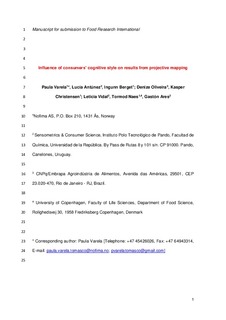| dc.contributor.author | Varela, Paula | |
| dc.contributor.author | Antúnez, Lucía | |
| dc.contributor.author | Berget, Ingunn | |
| dc.contributor.author | Oliveira, Denize | |
| dc.contributor.author | Christensen, Kasper | |
| dc.contributor.author | Vidal, Leticia | |
| dc.contributor.author | Næs, Tormod | |
| dc.contributor.author | Ares, Gastón | |
| dc.date.accessioned | 2018-04-17T11:01:31Z | |
| dc.date.available | 2018-04-17T11:01:31Z | |
| dc.date.created | 2017-07-25T12:49:21Z | |
| dc.date.issued | 2017 | |
| dc.identifier.citation | Food Research International. 2017, 99 (1), 693-701. | nb_NO |
| dc.identifier.issn | 0963-9969 | |
| dc.identifier.uri | http://hdl.handle.net/11250/2494453 | |
| dc.description.abstract | Projective mapping (PM), one of the most holistic product profiling methods in approach, is increasingly being used to uncover consumers' perception of products and packages. Assessors rely on a process of synthesis for evaluating product information, which would determine the relative importance of the perceived characteristics they use for mapping them. Individual differences are expected, as participants are not instructed on the characteristics to consider for evaluating the degree of difference among samples, generating different perceptual spaces. Individual differences in cognitive style can affect synthesis processes and thus their perception of similarities and differences among samples. In this study, the influence of the cognitive style in the results of PM was explored. Two consumer studies were performed, one aimed at describing intrinsic sensory characteristics of chocolate flavoured milk and the other one looking into extrinsic (package only) of blueberry yogurts. Consumers completed the wholistic-analytic module of the extended Verbal Imagery Cognitive Styles Test & Extended Cognitive Style Analysis-Wholistic Analytic Test, to characterize their cognitive style. Differences between wholistic and analytic consumers in how they evaluated samples using projective mapping were found in both studies. Analytics separated the samples more in the PM perceptual space than wholistic consumers, showing more discriminating abilities. This may come from a deeper analysis of the samples, both from intrinsic and extrinsic point of views. From a sensory perspective (intrinsic), analytic consumers relied on more sensory characteristics, while wholistic mainly discriminated samples according to sweetness and bitterness/chocolate flavour. In the extrinsic study however, even if analytic consumers discriminated more between packs, they described the products using similar words in the descriptive step. One important recommendation coming from this study is the need to consider higher dimensions in the interpretation of projective mapping tasks, as the first dimensions could underestimate the complexity of the perceptual space; currently, most applications of PM consider two dimensions only, which may not uncover the perception of specific groups of consumers. | |
| dc.language.iso | eng | nb_NO |
| dc.title | Influence of consumers' cognitive style on results from projective mapping | nb_NO |
| dc.type | Journal article | nb_NO |
| dc.type | Peer reviewed | nb_NO |
| dc.description.version | acceptedVersion | |
| dc.source.pagenumber | 693-701 | nb_NO |
| dc.source.volume | 99 | nb_NO |
| dc.source.journal | Food Research International | nb_NO |
| dc.source.issue | 1 | nb_NO |
| dc.identifier.doi | 10.1016/j.foodres.2017.06.021 | |
| dc.identifier.cristin | 1483026 | |
| dc.relation.project | Norges forskningsråd: 262308 | nb_NO |
| dc.relation.project | Nofima AS: 201702 | nb_NO |
| dc.relation.project | Norges forskningsråd: 262303 | nb_NO |
| dc.relation.project | Nofima AS: 201703 | nb_NO |
| dc.relation.project | Nofima AS: 10841 | nb_NO |
| dc.relation.project | Norges forskningsråd: 233684 | nb_NO |
| cristin.unitcode | 7543,3,3,0 | |
| cristin.unitcode | 7543,3,2,0 | |
| cristin.unitname | Sensorikk, forbruker og innovasjon | |
| cristin.unitname | Råvare og prosess | |
| cristin.ispublished | true | |
| cristin.fulltext | postprint | |
| cristin.qualitycode | 1 | |
